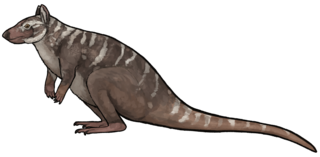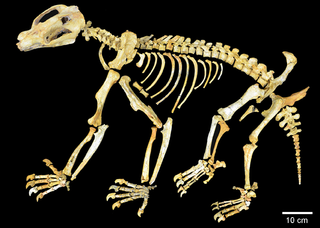
The order Peramelemorphia includes the bandicoots and bilbies. All members of the order are endemic to Australia-New Guinea and most have the characteristic bandicoot shape: a plump, arch-backed body with a long, delicately tapering snout, very large upright ears, relatively long, thin legs, and a thin tail. Their size varies from about 140 grams up to 4 kilograms, but most species are about one kilogram.

Bandicoots are a group of more than 20 species of small to medium sized, terrestrial, largely nocturnal marsupial omnivores in the order Peramelemorphia. They are endemic to the Australia–New Guinea region, including the Bismarck Archipelago to the east and Seram and Halmahera to the west.

Thylacinus is a genus of extinct carnivorous marsupials in the family Thylacinidae. The only recent member was the thylacine, commonly also known as the Tasmanian tiger or Tasmanian wolf. The last known Tasmanian tiger was in the Beaumaris Zoo in Tasmania, eventually dying in 1936. The earliest known member of the genus, Thylacinus macknessi appeared during the Early Miocene, around 16 million years ago, and was smaller than the modern thylacine, with a body mass of about 6.7–9.0 kilograms (14.8–19.8 lb). Thylacinus represented the only extant genus of the family after the beginning of the Pliocene around 5 million years ago. Over time members of the genus saw an increase in body mass and a greater adaption to hypercarnivory in their dental morphology.

Riversleigh World Heritage Area is Australia's most famous fossil location, recognised for the series of well preserved fossils deposited from the Late Oligocene to more recent geological periods. The fossiliferous limestone system is located near the Gregory River in the north-west of Queensland, an environment that was once a very wet rainforest that became more arid as the Gondwanan land masses separated and the Australian continent moved north. The approximately 100 square kilometres (39 sq mi) area has fossil remains of ancient mammals, birds, and reptiles of the Oligocene and Miocene ages, many of which were discovered and are only known from the Riversleigh area; the species that have occurred there are known as the Riversleigh fauna.

Wakaleo is an extinct genus of medium-sized thylacoleonids that lived in Australia in the Late Oligocene and Miocene Epochs.

Ekaltadeta is an extinct genus of marsupials related to the modern musky rat-kangaroos. Ekaltadeta was present in what is today the Riversleigh formations in Northern Queensland from the Late Oligocene to the Miocene, and the genus includes three species. The genus is hypothesized to have been either exclusively carnivorous, or omnivorous with a fondness for meat, based on the chewing teeth found in fossils. This conclusion is based mainly on the size and shape of a large buzz-saw-shaped cheek-tooth, the adult third premolar, which is common to all Ekaltadeta.

The genus Nimbacinus contains two species of carnivorous, quadrupedal marsupials in Australia both of which are extinct:

Nimbadon is an extinct genus of marsupial, that lived from the Oligocene to the Miocene. Many fossils have been found in the Riversleigh World Heritage property in north-western Queensland. It is thought to have an arboreal lifestyle.

Litokoala is an extinct genus of marsupials, and along with Nimiokoala, is closely related to the modern koala. The three genera may have diverged at an earlier date, although the drying of the continent and the expansion of Eucalyptus forests towards the late Miocene may have delayed the evolution of cranial features unique to the modern genera. This indicates that either fossil genus could be an ancestor of the modern genus, or the modern genus has a common ancestor to both. More material needs collection to improve their taxonomical relationships.
Maximucinus is an extinct genus of thylacinid that lived during the Middle Miocene in what is now Queensland, Australia. It is known only a second upper molar found at the Riversleigh World Heritage Area. It was the largest thylacinid of its time, attaining a body size of 18 kg. The genus is monotypic, containing only one species, Maximucinus muirheadae.

Muribacinus is an extinct genus of thylacinid that lived during the middle Miocene in what is now northwestern Queensland, Australia. It was described in 1995 from remains collected at the Riversleigh World Heritage Area. Only one species is known, M. gadiyuli.
Tyarrpecinus is an extinct genus of thylacinid that lived during the late Miocene in what is now the Northern Territory, Australia. It is known only from a partial skull bone that was reconstructed from numerous fragments. It was a small thylacinid and represents a late surviving relict. The genus is monotypic, containing only one species, Tyarrpecinus rothi.
Naraboryctes philcreaseri is a fossil species of marsupial found at early Miocene deposits of Boodjamulla National Park of Riversleigh area, northwestern Queensland, Australia.
Malleodectes is an extinct genus of unusual marsupial, first discovered in 2011 at Riversleigh, Queensland, Australia.
Priscakoala is an extinct genus of koala from the Early Miocene of Riversleigh, Australia. It has one species: Priscakoala lucyturnbullae.
Bulungu is an extinct genus of bandicoot-like mammal from Oligo-Miocene deposits of Riversleigh, northwestern Queensland, and the Etadunna Formation, Australia. It was first named by Gurovich et al. (2013) and the type species is Bulungu palara. Two additional species, Bulungu campbelli and Bulungu minkinaensis, were also described in 2013. Bulungu muirheadae is the oldest fossil bandicoot recovered to date. An additional three species Bulungu minkinaensis, Bulungu pinpaensis, and Bulungu westermani were named by Travouillon, Beck & Case (2021) allowing for placement of the genus in the superfamily Yaraloidea.
Cookeroo is a genus of extinct kangaroos from the Late Oligocene and Early Miocene found in fossil deposits from the Riversleigh World Heritage Area, in Australia. The genus includes two species, C. bulwidarri and C. hortusensis.
Lekaneleo is a fossil genus of carnivorous marsupial that existed during the early Miocene in Australia. Once allied to the type species of the genus Priscileo, later placed as Wakaleo pitikantensis, "Priscileo" roskellyae was subsequently transferred to its own genus Lekaneleo.
Ganbulanyi djadjinguli is a fossil species of Miocene dasyurid, described in 1998 and assigned to a new genus. The dentition has characteristics exhibited by mammals known as bone-crackers, a type of durophagy in which the animal is able to obtain to extract food contained in bony material. The amount of fossil material is inadequate to place this taxon within the Dasyuromorph order, but affinities are recognised with the Sarcophilus, the Tasmanian devil, and the extinct species Barinya wangala.
Whollydooleya tomnpatrichorum is a fossil species discovered just beyond the Riversleigh World Heritage Area, an early example of adaptations to hypercarnivory. The dating of the deposit, while uncertain, is associated with material assigned to the genus Ekaltadeta, placing its occurrence in the middle or late Miocene epoch.











